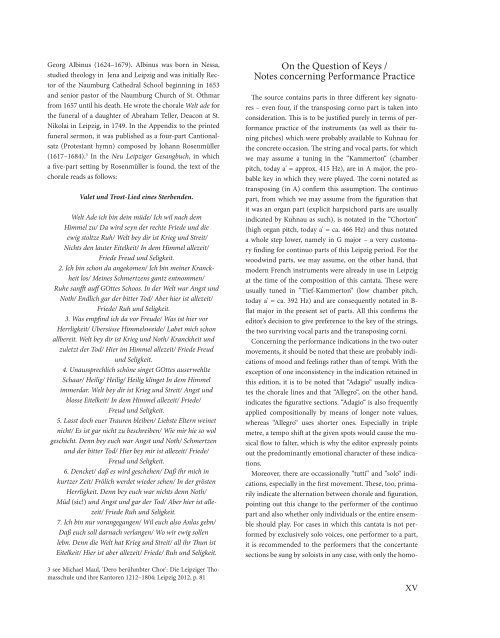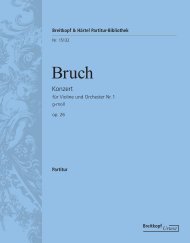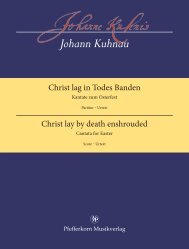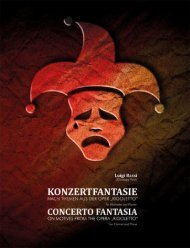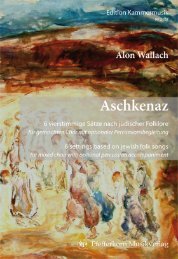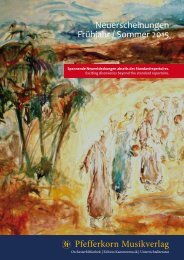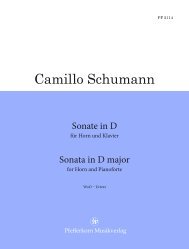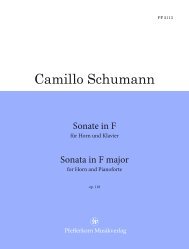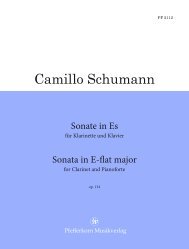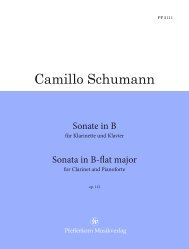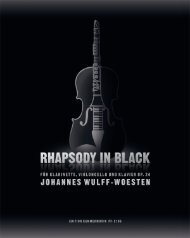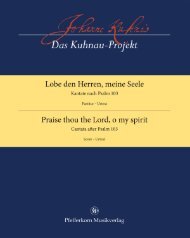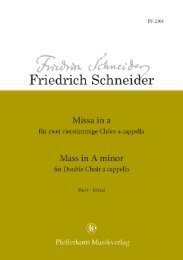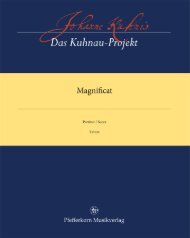PF-2092
Johann Kuhnau Welt adieu, ich bin dein müde / World adieu, I tire of you
Johann Kuhnau Welt adieu, ich bin dein müde / World adieu, I tire of you
Sie wollen auch ein ePaper? Erhöhen Sie die Reichweite Ihrer Titel.
YUMPU macht aus Druck-PDFs automatisch weboptimierte ePaper, die Google liebt.
Georg Albinus (1624–1679). Albinus was born in Nessa,<br />
studied theology in Jena and Leipzig and was initially Rector<br />
of the Naumburg Cathedral School beginning in 1653<br />
and senior pastor of the Naumburg Church of St. Othmar<br />
from 1657 until his death. He wrote the chorale Welt ade for<br />
the funeral of a daughter of Abraham Teller, Deacon at St.<br />
Nikolai in Leipzig, in 1749. In the Appendix to the printed<br />
funeral sermon, it was published as a four-part Cantionalsatz<br />
(Protestant hymn) composed by Johann Rosenmüller<br />
(1617–1684). 3 In the Neu Leipziger Gesangbuch, in which<br />
a five-part setting by Rosenmüller is found, the text of the<br />
chorale reads as follows:<br />
Valet und Trost-Lied eines Sterbenden.<br />
Welt Ade ich bin dein müde/ Ich wil nach dem<br />
Himmel zu/ Da wird seyn der rechte Friede und die<br />
ewig stoltze Ruh/ Welt bey dir ist Krieg und Streit/<br />
Nichts den lauter Eitelkeit/ In dem Himmel allezeit/<br />
Friede Freud und Seligkeit.<br />
2. Ich bin schon da angekomen/ Ich bin meiner Kranckheit<br />
los/ Meines Schmertzens gantz entnommen/<br />
Ruhe sanfft auff GOttes Schoos. In der Welt war Angst und<br />
Noth/ Endlich gar der bitter Tod/ Aber hier ist allezeit/<br />
Friede/ Ruh und Seligkeit.<br />
3. Was empfind ich da vor Freude/ Was ist hier vor<br />
Herrligkeit/ Ubersüsse Himmelsweide/ Labet mich schon<br />
allbereit. Welt bey dir ist Krieg und Noth/ Kranckheit und<br />
zuletzt der Tod/ Hier im Himmel allezeit/ Friede Freud<br />
und Seligkeit.<br />
4. Unaussprechlich schöne singet GOttes auserwehlte<br />
Schaar/ Heilig/ Heilig/ Heilig klinget In dem Himmel<br />
immerdar. Welt bey dir ist Krieg und Streit/ Angst und<br />
blosse Eitelkeit/ In dem Himmel allezeit/ Friede/<br />
Freud und Seligkeit.<br />
5. Lasst doch euer Trauren bleiben/ Liebste Eltern weinet<br />
nicht/ Es ist gar nicht zu beschreiben/ Wie mir hie so wol<br />
geschicht. Denn bey euch war Angst und Noth/ Schmertzen<br />
und der bitter Tod/ Hier bey mir ist allezeit/ Friede/<br />
Freud und Seligkeit.<br />
6. Dencket/ daß es wird geschehen/ Daß ihr mich in<br />
kurtzer Zeit/ Frölich werdet wieder sehen/ In der grösten<br />
Herrligkeit. Denn bey euch war nichts denn Noth/<br />
Müd (sic!) und Angst und gar der Tod/ Aber hier ist allezeit/<br />
Friede Ruh und Seligkeit.<br />
7. Ich bin nur vorangegangen/ Wil euch also Anlas gebn/<br />
Daß euch soll darnach verlangen/ Wo wir ewig sollen<br />
lebn. Denn die Welt hat Krieg und Streit/ all ihr Thun ist<br />
Eitelkeit/ Hier ist aber allezeit/ Friede/ Ruh und Seligkeit.<br />
3 see Michael Maul, 'Dero berühmbter Chor': Die Leipziger Thomasschule<br />
und ihre Kantoren 1212–1804; Leipzig 2012, p. 81<br />
On the Question of Keys /<br />
Notes concerning Performance Practice<br />
The source contains parts in three different key signatures<br />
– even four, if the transposing corno part is taken into<br />
consideration. This is to be justified purely in terms of performance<br />
practice of the instruments (as well as their tuning<br />
pitches) which were probably available to Kuhnau for<br />
the concrete occasion. The string and vocal parts, for which<br />
we may assume a tuning in the “Kammerton“ (chamber<br />
pitch, today a' = approx. 415 Hz), are in A major, the probable<br />
key in which they were played. The corni notated as<br />
transposing (in A) confirm this assumption. The continuo<br />
part, from which we may assume from the figuration that<br />
it was an organ part (explicit harpsichord parts are usually<br />
indicated by Kuhnau as such), is notated in the “Chorton“<br />
(high organ pitch, today a' = ca. 466 Hz) and thus notated<br />
a whole step lower, namely in G major – a very customary<br />
finding for continuo parts of this Leipzig period. For the<br />
woodwind parts, we may assume, on the other hand, that<br />
modern French instruments were already in use in Leipzig<br />
at the time of the composition of this cantata. These were<br />
usually tuned in “Tief-Kammerton“ (low chamber pitch,<br />
today a' = ca. 392 Hz) and are consequently notated in B-<br />
flat major in the present set of parts. All this confirms the<br />
editor’s decision to give preference to the key of the strings,<br />
the two surviving vocal parts and the transposing corni.<br />
Concerning the performance indications in the two outer<br />
movements, it should be noted that these are probably indications<br />
of mood and feelings rather than of tempi. With the<br />
exception of one inconsistency in the indication retained in<br />
this edition, it is to be noted that “Adagio“ usually indicates<br />
the chorale lines and that “Allegro“, on the other hand,<br />
indicates the figurative sections. “Adagio“ is also frequently<br />
applied compositionally by means of longer note values,<br />
whereas “Allegro“ uses shorter ones. Especially in triple<br />
metre, a tempo shift at the given spots would cause the musical<br />
flow to falter, which is why the editor expressly points<br />
out the predominantly emotional character of these indications.<br />
Moreover, there are occassionally “tutti“ and “solo“ indications,<br />
especially in the first movement. These, too, primarily<br />
indicate the alternation between chorale and figuration,<br />
pointing out this change to the performer of the continuo<br />
part and also whether only individuals or the entire ensemble<br />
should play. For cases in which this cantata is not performed<br />
by exclusively solo voices, one performer to a part,<br />
it is recommended to the performers that the concertante<br />
sections be sung by soloists in any case, with only the homo-<br />
XV


